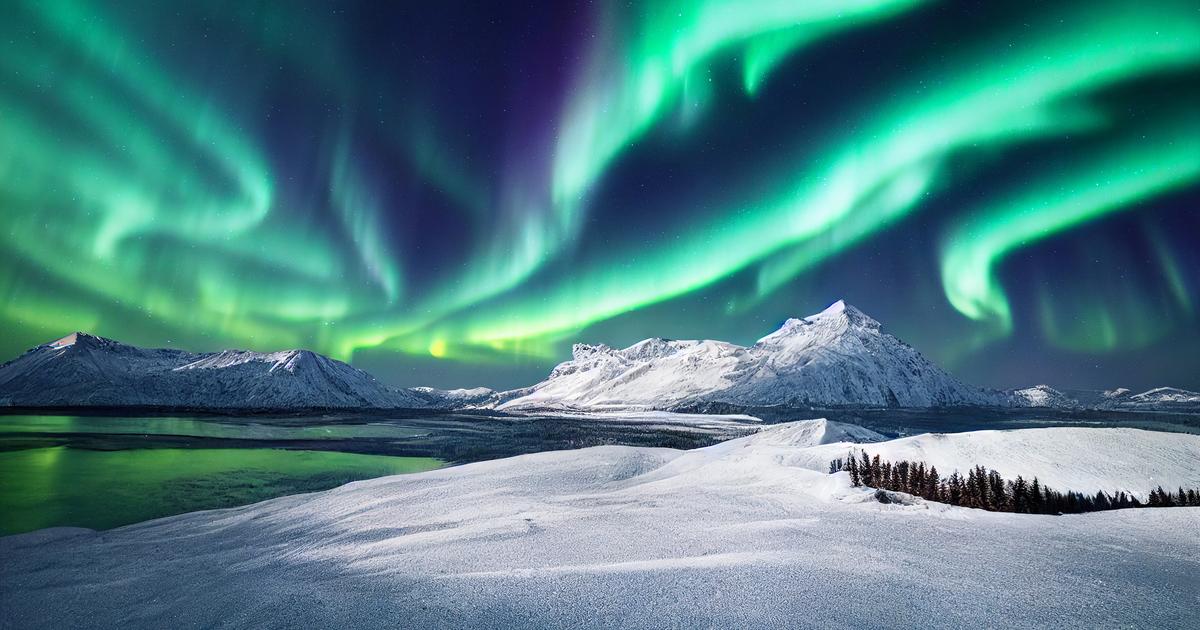It is one of the most beautiful natural spectacles.
The Northern Lights set the night skies ablaze in some northern regions of the globe.
Their silent beauty almost makes us forget their origins and causes.
What is an aurora borealis and how does it form?
What are the best places in the world to see them, and when is the best time?
In winter, let's not let our travel dreams fall asleep, and let's go under the stars.
Read alsoFinnish Lapland: "How I almost missed my first aurora borealis"
What is an aurora borealis?
A luminous natural phenomenon resulting from a solar eruption, the aurora borealis appears in the form of colored clouds.
elizabeth
The beliefs of the Far North (shamanic, Eskimo, Celtic, Amerindian, etc.), derived from myths and legends, have attributed these strange celestial phenomena to the souls of deceased ancestors.
Some have associated them with bad omens, others have attributed supernatural powers to these apparitions.
Since then, science has contradicted all these beliefs.
An aurora borealis is a luminous natural phenomenon resulting from a solar eruption, and which unfolds in the sky.
The surface of the sun emits particles (protons, electrons and ions) at supersonic speed;
this emission or solar eruption is called “solar wind”.
At the same time, the Earth's magnetic field creates a natural shield that protects the Earth from incoming solar particles.
But there.
At the poles, the magnetic field that protects our planet is weakened, and charged solar particles are guided towards these poles, which then exert a powerful magnet effect.
This is why the aurora borealis appears there, and this explains the generic expression of “polar aurora”: aurora borealis in the northern hemisphere, austral in the southern hemisphere.
In the upper layer of the atmosphere (upper atmosphere or ionosphere), the energetically charged solar particles collide with the atoms or gases present in the Earth's upper atmosphere (mainly oxygen, hydrogen and nitrogen).
During this collision, the solar particles ignite, generating luminous bursts which leave colored lights, streaks or clouds in the clear sky.
Some appear simultaneously.
And as they move, these nebulous veils seem to dance across the sky.
What are the conditions for observing the aurora borealis?
To best observe an aurora borealis, the night must be dark and the sky devoid of any light pollution.
Den Belitsky
For an aurora borealis to form, a whole series of meteorological and atmospheric conditions must be met;
the aurora borealis would therefore be the result of a sort of alignment of the stars.
It occurs rather in winter, in the sky of the northern hemisphere.
Of course, you have to wait until nightfall.
The spectacle is observed in the so-called “auroral” zone, located between 60 and 75°C latitude.
The night must be dark, preferably long, and the sky, devoid of any light pollution, which requires moving away from the cities.
Also, a moon that is too bright can affect the visibility of an aurora borealis;
the lunar calendar is therefore to be monitored, avoiding full moon nights.
In order to be seen with the naked eye, the aurora borealis must reach a minimum intensity.
In other words, a certain density of particles is necessary.
Thus in Iceland, the aurora borealis occur all year round, but are only really visible from a certain intensity, between September and April.
If the most active zone of aurora borealis is located near the North Pole, in a geomagnetic storm, the possible observation zone is larger, and their visibility better.
They are then visible from lower latitudes, especially from the Baltic countries (Estonia, Latvia and Lithuania).
When is the best time to see the Northern Lights?
The period between early fall and early spring is ideal for viewing the Northern Lights.
simone
The Northern Lights eruption period is between late August or September and March-April.
But the period when they are the most ample is during the winter months, between September 21 and March 21.
Advantage in this winter period: the nights are very long.
The end of winter, from February to April, is another favorable period for other reasons: the nights are still long, and the sky in the Far North is more often clear than in the heart of winter.
In Finnish Lapland, it is even in April that the conditions are optimal.
As for the optimal time slot, it is between 6-8 p.m. and midnight-1 a.m.;
and at the peak of auroral activity, over an extended time slot, from 6 p.m. to 3 a.m.
Why do the Northern Lights change color?
While the Northern Lights are most often a fluorescent green color, they also sport purple colors or shades of blue, like here in Norway.
waichi2013th
The color of an aurora borealis depends on two factors: the nature of the elements in collision (atoms and molecules, and ions), and the altitude at which this collision occurs.
While the Northern Lights are most often a fluorescent green color, they can also sport purple colors or shades of blue, yellow, orange or reddish tones.
Green, red and then blue are the three colors that the human eye perceives best.
But
ultimately
, all the shades of the chromatic circle are observable.
We can detect in some clouds gradations from one shade to another
.
As for the altitude, most of the aurora borealis occur between 90 and 1,000 km in height.
Let's summarize.
Green, the most common color, indicates that particles have collided with oxygen molecules between 100 and 300 km altitude;
pink and dark red reflect the presence of nitrogen molecules, and a collision at about 100 km height;
red, the existence of oxygen atoms, and a collision beyond 250 km, generally between 300 and 400 km altitude;
blue and purple-purple, the presence of nitrogen, hydrogen and helium molecules, below 100 km (blue), and above 100 km altitude (purple).
These last two shades, blue and purple, are of course more difficult to perceive with the naked eye, against the background of the night sky.
What are the best places to watch the Northern Lights?
Norway, Sweden... Head for the Scandinavian countries or Finland for a chance to observe the Northern Lights.
Here they were immortalized in the Lofoten Islands.
f11photo
The aurora borealis is observed in the Far North.
Starting from this premise, it is important to choose your destination carefully, but the horizon of possibilities remains vast.
Go to Scandinavia, the favorite land of northern lights hunters, from Norway to Finland via Sweden, as well as in northern Russia.
The more intense the auroral activity, the more the area of visibility of the aurora will decrease in latitude.
In Norway, we post from the Lofoten Islands to the North Cape, via Tromsø and the Svalbard archipelago.
In Tromsø, Lake Prestvannet is a popular spot for observation, as are the nearby islands of Kvaløya and Sommarøy.
We should also mention Finnmark, in Norwegian Lapland.
In Sweden, head for the forests of Swedish Lapland.
The Aurora Sky Station viewing center at the tip of Abisko National Park is said to be Sweden's best viewing spot.
We should also mention the mining town of Kiruna, and Jukkasjärvi.
In Finland, Northern Lights hunting leads to Finnish Lapland.
They appear there above the fir forests and the lakes frozen in the ice, in the region of Ivalo and in the Urho Kekkonen National Park.
Read alsoBetween Norway, Sweden or Finland: where to go to discover the northern lights of Lapland?
The Northern Lights can also be admired under the Celtic skies of Scotland, in the Highlands and the Far North, the Shetland and Orkney Islands, and as far as the Isles of Lewis and Harris, the Isle of Skye and the Cairngorms.
Further north, they are admired from the Faroe Islands, where the most favorable period is at the height of winter, between November and February.
Iceland is also a great destination to see the Northern Lights.
From October to March, they unfold in the Reykjavík region, above volcanoes and glaciers, and above Lake Mývatn.
At these same latitudes, northern lights hunters can change longitude and cross the Atlantic towards North America.
Then head for Canada, more precisely the great Canadian North: Alberta (Wood Buffalo National Park), Saskatchewan, Yukon (Whitehorse region), Northwest Territories (Yellowknife region) and Nunavut, and, to a lesser extent, northern Quebec.
The territory of the United States also benefits from this magical spectacle from the boreal forests of Alaska (Fairbanks, Anchorage, National Park and Denali Preserve).
The less cautious will push the trip to the northern ends of the earth, in Greenland.
They will post their tripod in the regions of the capital Nuuk, Kangerlussuaq, Ilulissat (west coast) and Tasiilaq (east coast).
Read alsoWhen to go to Norway?
Northern lights, weather… The best period by region
Tips for seeing the Northern Lights
The destinations offer various observation formulas: excursions, safaris, or all-inclusive formulas, with observation circuits, accommodation (in a chalet, glass igloo, ice hotel or trapper's cabin), and other winter activities (outings in dog sleds, snowshoes, cross-country skiing, sauna...).
Several forecast sites and apps monitor auroral activity in real time, and provide predictions.
These tools announce, identify and locate the aurora borealis, assess the probability of seeing them depending on the sector, and this, a few hours or even a few days in advance.
However, there is no question of planning your trip, or even your itinerary, based on these forecasts, because you have to keep in mind that the appearance of the boreal phenomenon is never a guarantee.
It remains a privilege and a miracle.
Seeing the Northern Lights cannot be an end in itself, but should rather be considered as the little extra of the trip, or its crowning glory.
And the best advice for all aurora borealis hunters, whatever the length: arm yourself with patience!
See also -
Northern lights light up the Lappish sky












